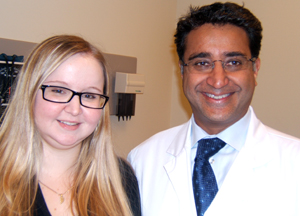2011 has been an excellent year for Brittany Henry. At 24 years of age, she is still alive. And well enough to graduate from the University of Western Ontario, with a specialization in Family Studies. And receive her coveted diploma in person, ready to pursue her dream job of working with hospital patients. All this, 10 years after her life-altering double lung transplant.
 Brittany suffered from cystic fibrosis, a chronic and progressive disease in which mucous builds up, clog passages and results in lung infections. There is no cure. She received her lung transplant at the age of 14 from Dr. Shaf Keshavjee, Surgeon-in-Chief, UHN, and pioneering lung transplant surgeon-scientist.
Brittany suffered from cystic fibrosis, a chronic and progressive disease in which mucous builds up, clog passages and results in lung infections. There is no cure. She received her lung transplant at the age of 14 from Dr. Shaf Keshavjee, Surgeon-in-Chief, UHN, and pioneering lung transplant surgeon-scientist.
"The second I woke up from surgery, I forgot what it was like to have cystic fibrosis in my lungs," says Brittany. "I didn't remember the coughing fits, the difficulty in breathing and the lack of energy. For the first time, I felt good."
Brittany had been on oxygen day and night, and was in a wheelchair for two years before her transplant.
Dr. Keshavjee notes that just a couple decades ago, the likelihood that a child with cystic fibrosis would live until his or her 18th birthday was slim—but transplantation has changed this reality. In 1988, TGH was the first hospital in the world to successfully transplant the lungs of a patient with cystic fibrosis, and the first hospital in 1986 to successfully perform a double lung transplant.
Advances in organ preservation and repair techniques, suppression of the immune system and the long-term monitoring and care of lung transplant recipients help account for improved survival rates and more transplants. In the 1980s, transplantation was a high-risk operation, and patients were given an estimate of 50% as a chance of dying from the surgery. At TGH, that number has been reduced dramatically to 6% deaths of lung transplant patients during surgery. TGH performs about 100 lung transplants a year, making it one of the largest programs in the world.
A 2008 study by the Canadian Institute for Health Information found that about a third of all lung transplants are people with cystic fibrosis. The study also noted that the three-year survival rate of lung transplant patients increased from 60% in 1997 to 80% in 2003. At 10 years, about 40% of all cystic fibrosis patients who underwent a transplant are still alive.
"Now the focus on outcomes from transplantation is not just survival – and it is fantastic that more patients are alive! – but it's that recipients are getting back to meaningful and productive lives," says Dr. Keshavjee.
Life is indeed looking up for Brittany. "Life is good," she smiles, adding that, "Hey, I made it 10 years after transplant. I'm no longer the sick kid."
